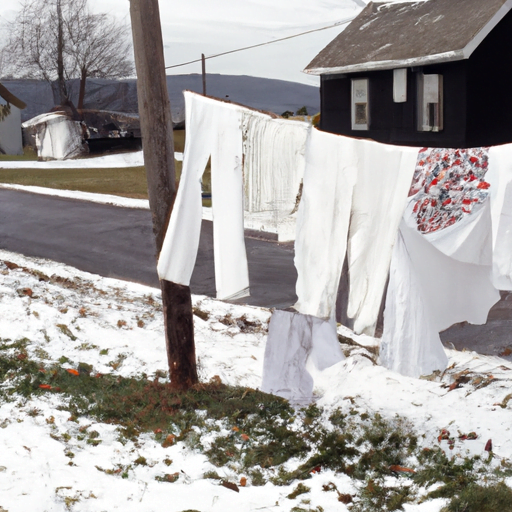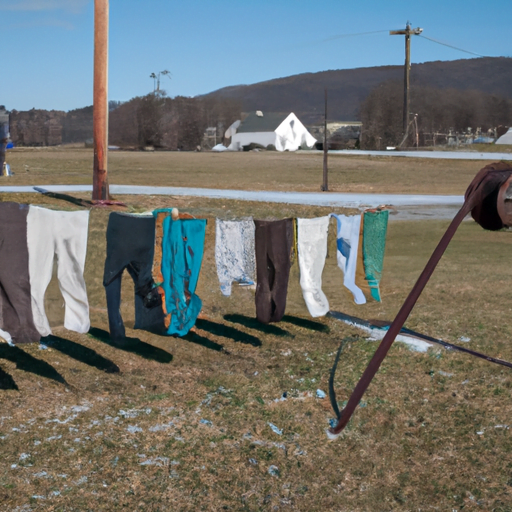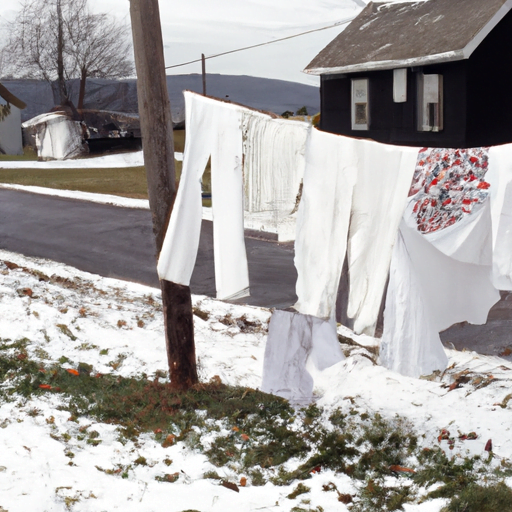Have you ever wondered how people living off the grid manage to do everyday tasks without relying on modern amenities? One particular aspect that may come to mind is laundry. I mean, how do they dry their clothes in the winter when the sun isn’t out as often? Well, interestingly enough, the Amish have found a practical solution to this problem. In this article, we will explore how the Amish dry their clothes in the winter and uncover some helpful tips for off grid living.
During the winter months, when the weather is colder and the sun is less visible, the Amish utilize a simple yet effective method to dry their clothes. Instead of using electric dryers or hanging laundry outside, the Amish rely on air-drying indoors. They employ a system of hanging clotheslines in their basements, attics, or even purpose-built drying rooms. By utilizing the dry heat from wood stoves or other sources, they create a warm and well-ventilated space for clothes to dry naturally.
The Amish also make use of additional tools to aid in the drying process. For instance, they often hang clothes on wooden racks or lay them flat on clean surfaces, allowing for better airflow and quick evaporation of moisture. They prioritize the management of humidity levels in their homes and ensure proper ventilation to prevent dampness. With these strategies, the Amish are able to effectively dry their clothes in the winter without relying on electricity or the sun’s warmth.
Living off the grid can be challenging, but the Amish have honed their techniques for generations. By adopting their methods, you can learn how to dry your clothes efficiently in the winter without resorting to modern conveniences. In the article that follows, we will delve deeper into the specifics of the Amish drying process, exploring the materials they use, the ideal conditions for drying, and other handy tips for off grid living. Stay tuned to discover the secrets of the Amish and how you can apply their wisdom to your own lifestyle.

Introduction
Off-grid living is a lifestyle that has gained popularity in recent years as people become more conscious of their carbon footprint and the impact of modern utilities on the environment. It involves living in a self-sufficient manner, relying on renewable energy sources and finding alternative solutions to everyday tasks. One aspect of off-grid living is the way clothes are dried, especially during the winter months. In this article, we will explore the traditional Amish way of drying clothes in the winter and discover some innovative techniques that can be adapted to modern off-grid living.
Understanding Off Grid Living
To fully appreciate the Amish way of drying clothes in the winter, it is important to understand the concept of off-grid living. Off-grid living refers to living without the reliance on public utilities such as water, electricity, and gas. Instead, individuals or communities generate their own power through renewable sources like solar panels, wind turbines, or hydroelectric systems. This self-sufficiency allows for a more sustainable and eco-friendly lifestyle.
The Amish Way of Life
The Amish community is known for its commitment to off-grid living. They live a simple and traditional lifestyle, adhering to strict religious beliefs and rejecting modern conveniences. The Amish believe in simplicity, hard work, and community support. One of the aspects that sets them apart is their unique way of drying clothes, especially during the winter months when the weather is harsh and outdoor drying is not feasible.
Challenges of Off Grid Living
Living off the grid presents its own set of challenges, and drying clothes is no exception. While modern households have the luxury of electric or gas-powered dryers that provide quick and efficient drying, off-grid living requires alternative solutions. Two significant challenges faced by those living off the grid are limited access to modern utilities and seasonal limitations.
Limited Access to Modern Utilities
Off-grid communities often have limited or no access to public utilities. This means they cannot rely on electric or gas-powered dryers and must find alternative methods for drying clothes. This limitation forces them to think creatively and adapt traditional methods to fit their needs.
Seasonal Limitations
Winter poses a unique challenge for off-grid living. Extreme cold temperatures and inclement weather conditions make it difficult to dry clothes outdoors. The lack of sunlight and freezing temperatures prevent clothes from drying effectively. As a result, off-grid communities must come up with innovative techniques to dry clothes indoors during the winter months.

Importance of Proper Clothes Drying
Proper clothes drying is essential for preserving clothing quality and preventing mold and mildew. When clothes are not dried efficiently, they can lose their shape, color, and overall quality. Additionally, insufficient drying can lead to the growth of mold and mildew, causing unpleasant odors and potential health hazards. Understanding the importance of proper clothes drying is crucial for off-grid living, and the Amish have developed methods to ensure this.
Preserving Clothing Quality
The Amish value the quality and longevity of their clothing. By using traditional drying methods, they are able to preserve the integrity of their clothes. Unlike electric or gas dryers that subject clothes to high heat, potentially causing shrinkage and damage, the Amish choose gentler methods that allow clothes to air dry naturally.
Preventing Mold and Mildew
In damp environments, clothes that are not dried properly can develop mold and mildew. These fungi thrive in dark and moist conditions, and if left untreated, they can lead to odors and health issues. The Amish have perfected their drying methods to ensure that clothes are thoroughly dried, thereby preventing the growth of mold and mildew.
Traditional Amish Clothes Drying Methods
The Amish have relied on tried and tested methods for drying clothes for generations. These traditional methods are adapted to their off-grid lifestyle and can be easily implemented by anyone seeking an alternative to electric or gas-powered dryers.
Outdoor Clotheslines
During the warmer months, Amish households utilize outdoor clotheslines to dry their laundry. This simple yet effective method allows clothes to be exposed to sunlight and fresh air, ensuring quick and efficient drying. Clotheslines can be set up between trees or posts, and with the use of pegs or clothespins, clothes are hung to dry.
Attic and Basement Drying Racks
Amish homes often have attics or basements that provide ideal environments for drying clothes during the winter months. Attic and basement drying racks are wooden frames or lines that can be hung from the ceiling. Clothes are spread out on these racks, and the natural heat rising from the house helps to dry them efficiently.
Stove and Fireplace Drying
Another traditional Amish method involves utilizing the heat generated by stoves and fireplaces for drying clothes. As the fire burns, the warm air circulates, and clothes hung nearby are dried by this indirect heat. This method requires careful placement of clothes to avoid direct exposure to flames or excessive heat, but when done correctly, it can be an effective way to dry clothes indoors.
Innovative Amish Techniques
While the Amish have relied on traditional methods for centuries, they have also embraced innovative techniques to adapt to the changing times. These techniques combine their values of sustainability and self-sufficiency with modern technology.
Harnessing Solar Energy
The Amish have found ways to harness the power of the sun for drying clothes. Solar-powered drying sheds have become popular in off-grid communities. These sheds are equipped with solar panels that capture sunlight and convert it into usable energy. The energy is then used to power fans or heaters, which create optimal drying conditions. Solar-powered drying sheds provide an efficient and eco-friendly solution for drying clothes, even during the winter months.
Using Wood-Burning Stoves for Drying
Wood-burning stoves are commonly used by the Amish for heating their homes. During the winter, when these stoves are in use, the heat generated can be utilized for drying clothes. By strategically placing clothes racks near the stove, the warm air produced can dry clothes effectively without the need for additional energy sources.
Insulated Drying Rooms
To combat the challenges of drying clothes in a cold and damp environment, some Amish households have created insulated drying rooms. These rooms are dedicated spaces where clothes can be hung to dry. They are well-insulated to retain heat and prevent moisture from seeping in. By creating a controlled environment, clothes can dry more efficiently and without the risk of freezing or developing mold.
Eco-Friendly Approaches
The Amish are committed to living sustainably and minimizing their environmental impact. In addition to harnessing solar energy and using wood-burning stoves, they have explored other eco-friendly approaches to drying clothes.
Solar-Powered Drying Sheds
As mentioned earlier, solar-powered drying sheds are an innovation embraced by the Amish. By utilizing solar panels to capture sunlight, these sheds provide an eco-friendly solution for drying clothes. The renewable energy generated by the panels eliminates the need for fossil fuel-powered drying methods, thus reducing carbon emissions.
Wind-Powered Drying Solutions
Wind power is another renewable energy source that the Amish have successfully incorporated into their drying practices. Some off-grid communities use wind turbines to generate electricity, which can then be used to power fans or heaters in drying areas. This sustainable approach reduces reliance on non-renewable resources and minimizes the environmental impact of clothes drying.
Modern Alternatives for Amish Dryers
While the Amish have perfected their traditional and innovative drying methods, modern alternatives can also be considered for off-grid living.
Propane-Powered Dryers
Propane-powered dryers provide a more modern and convenient option for drying clothes off-grid. Propane is a clean-burning fossil fuel that can be stored in tanks, making it a suitable alternative for households without access to natural gas. Propane dryers offer quick drying times and efficient performance, making them a viable option for those seeking a more convenient solution.
Portable Electric Dryers
Portable electric dryers are another option for off-grid living. These compact dryers are designed to be energy-efficient and can be powered by solar panels or batteries. Their compact size makes them perfect for small households or those living in tight spaces. While they may not be as energy-efficient as traditional drying methods, portable electric dryers offer convenience and ease of use.
Efficient Indoor Drying Tips
In addition to the Amish methods and modern alternatives, there are several tips that can help maximize indoor drying efficiency during the winter months.
Maximizing Indoor Heat
During the winter, it is important to maximize indoor heat to aid in the drying process. Keeping the house warm and maintaining a constant temperature helps clothes dry more quickly. You can achieve this by adjusting the thermostat or using additional heating sources such as wood-burning stoves or space heaters.
Utilizing Dehumidifiers
Drying clothes indoors can introduce moisture into the air, which can lead to an increase in humidity levels. To counteract this, using dehumidifiers can help remove excess moisture from the air. By reducing humidity, clothes can dry more effectively and prevent the growth of mold and mildew.
Proper Ventilation
Ensuring proper ventilation is crucial when drying clothes indoors. Opening windows or using fans can help circulate air and aid in the drying process. Proper ventilation prevents stale air from accumulating and promotes the flow of fresh air, allowing clothes to dry faster.
Tips for Drying Clothes in Winter
Drying clothes during the winter months presents its own set of challenges. Here are some tips to help you effectively dry your clothes in the winter off-grid.
Timing Your Laundry
Timing your laundry is essential when drying clothes in the winter. Choose a day when the weather is relatively mild or when the sun is shining. This will provide the best conditions for drying clothes outdoors, especially if you rely on traditional methods like clotheslines.
Avoiding Excess Moisture
During the winter, it is important to minimize excess moisture in your home. Excessive moisture can prolong the drying process and create a damp environment, increasing the risk of mold and mildew. Be mindful of activities that generate moisture, such as cooking or showering, and take steps to minimize their impact on your drying efforts.
Preventing Freezing
Freezing temperatures can complicate the drying process in winter off-grid living. Wet clothes exposed to freezing temperatures can become rigid and take longer to dry. To prevent freezing, make sure to shake out clothes before hanging them and ensure they are completely dry before bringing them indoors.
Conclusion
Embracing simplicity in off-grid living is a philosophy that the Amish have perfected over the years. Their unique and innovative methods of drying clothes in the winter offer valuable insights and inspiration for anyone seeking a self-sufficient and sustainable lifestyle. By adapting traditional methods to fit modern needs and exploring eco-friendly alternatives, off-grid communities can effectively dry clothes throughout the year while minimizing their impact on the environment. Whether through solar-powered drying sheds, wood-burning stoves, or efficient indoor drying techniques, off-grid living can provide a fulfilling and environmentally conscious way of life.




